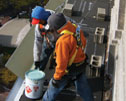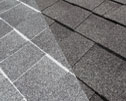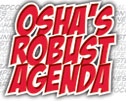NRCA and the Midwest Roofing Contractors Association (MRCA) have revised their guidelines for safely torch applying polymer-modified bitumen sheet products. Specifically, the changes affect safety practice recommendations for applying polymer-modified bitumen membrane flashings over combustible substrates.
The changes are reflected in the current Certified Roofing Torch Applicator (CERTA) program, which provides training in the latest safety practices and industry requirements for torching activities through the combined use of manuals, video instruction and a hands-on training class. It is the only program of its kind available in the roofing industry.
The program's curriculum was developed in 1986 through joint efforts of MRCA; the Asphalt Roofing Manufacturers Association; and United Union of Roofers, Waterproofers and Allied Workers. In 2003, the insurance industry approached NRCA to address concerns about increasing incidents and losses occurring during torching activities by roofing workers. NRCA arranged with MRCA to adopt and revise the CERTA program to meet this industry need.
Older recommendations
The NRCA Roofing Manual: Membrane Roof Systems—2007 provides NRCA's previous recommendations for safely applying torched polymer-modified bitumen roof membranes. The CERTA program revision in July 2007 made NRCA's recommendations for torching over combustible substrates mandatory for certified applicators.
The July 2007 CERTA program required incorporating an above-deck thermal barrier into a roof system's design before installing torch-applied membranes for field-of-roof and membrane flashing applications over combustible substrates. Combustible substrate types include plywood, oriented strand board, wood plank, wood board and wood fiberboard. Acceptable thermal barrier materials were identified as a minimum 3/4-inch-thick perlite board insulation, minimum 3/4-inch-thick fiberglass or mineral wool board insulation, and minimum 1/4-inch-thick glass-faced gypsum board. The requirement for thermal barriers in field-of-roof applications remains unchanged in the revised guidelines.
According to 2007 CERTA requirements, torch-applied polymer-modified bitumen membrane flashings over combustible flashing substrates required the installation of an air-impermeable backer ply before torching began. Three acceptable backer configurations were identified:
- One layer of fiberglass ply sheet, fiberglass base sheet or polymer-modified bitumen base sheet fastened to the substrate and an additional layer of fiberglass ply sheet, fiberglass base sheet or polymer-modified bitumen base sheet adhered to the first layer using hot asphalt
- One layer of fiberglass ply sheet, fiberglass base sheet or polymer-modified bitumen base sheet fastened to the substrate and an additional layer of self-adhering, smooth-surfaced polymer-modified bitumen sheet adhered to the first layer
- Two layers of fiberglass ply sheet, fiberglass base sheet or polymer-modified bitumen base sheet adhered in solid moppings of hot asphalt
Because of concerns about fire safety during membrane flashing installation over combustible substrates, NRCA did not recommend preheating flashing backers and underlying substrates with open-flame torches or torching directly to backers. Instead, the torch-and-flop technique was NRCA's preferred method for torch-applied polymer-modified bitumen membrane flashings in such situations.
Accordingly, the CERTA manuals described the torch-and-flop technique as the most effective work practice available to minimize the risk of fire when using a torch. Torch-and-flop was the only torching technique prescribed by CERTA for torch-applied membrane flashings over combustible substrates.
Groundwork for changes
Also in 2007, NRCA retained Hughes Associates Inc., Baltimore, a nationally recognized fire consulting firm, to help plan and conduct a test program designed to investigate heat transmission through component layers of torch-applied polymer-modified bitumen membrane flashings during installation over combustible substrates.
The test program used wood-framed parapet wall mock-ups covered with 5/8-inch-thick construction-grade plywood sheathing.
For each test assembly, a different flashing configuration was used. Three flashing backer sheet types and three cap sheet types were used in eight configurations, three of which also included a 1/4-inch-thick layer of glass-faced gypsum board thermal barrier directly over the plywood sheathing. All flashing backers were nailed to the substrate. Cap sheets in six test assemblies were installed using the direct torching method; two were installed using the torch-and-flop technique. A 400,000-British thermal unit (Btu) handheld field torch was used.
In all test assemblies, a thermocouple was installed at each interface between component layers and on the back face of the plywood sheathing, which was exposed to ambient conditions. Output from the thermocouples was logged during a 10-minute period for each test assembly at a rate of 10 times per second. In this way, a set of time-temperature profiles was obtained for component interface locations in each test assembly during torching and the cooling period immediately following.
Findings
Among the test program's findings, of greatest significance for torch-applied membrane flashings is the fact the maximum temperature recorded at the flashing backer sheet and substrate (plywood or 1/4-inch-thick glass-faced gypsum board) interface was 392 F. This value was nearly consistent for all test assemblies.
The maximum temperature recorded at the front face of plywood sheathing in test assemblies, which included a 1/4-inch-thick glass-faced gypsum board thermal barrier, was 212 F. The temperatures recorded at the back face of plywood remained at ambient levels for all test assemblies during the entire temperature-logging interval.
Also significant, it was found temperatures remained near their maximum re-corded values for short time periods coinciding with the torch flame being in the direct vicinity of the thermocouple. Recorded temperatures quickly decreased when the torch flame was moved as little as several inches away from the thermocouple.
Evaluation
The maximum flashing backer sheet and substrate interface temperature recorded during the test program is a good benchmark of the maximum temperature that occurs at the surface of combustible substrate materials during typical rooftop installations of torch-applied polymer-modified bitumen membrane flashings. It was compared with the ignition temperatures of commonly used combustible construction materials.
NRCA's research of published sources established wood's piloted ignition (initiated by flame, sparks or embers) generally occurs between 660 and 690 F for softwood species and between 570 and 590 F for hardwood species. Wood autoignites between 950 and 1,022 F. The autoignition point is the lowest temperature at which a material spontaneously catches fire. Published sources report wood sheathing products have ignition properties similar to solid wood of the same species.
The 392 F maximum temperature recorded at the front face of plywood sheathing is at least 178 degrees lower than the piloted ignition temperatures and at least 558 degrees lower than the autoignition temperatures for wood. The recorded maximum to ingition point temperature differentials at the front face of plywood sheathing in the test assemblies incorporating a 1/4-inch-thick glass-faced gypsum board thermal barrier are at least 358 degrees and 738 degrees, respectively, based on the maximum recorded temperature of 212 F.
The piloted ignition temperatures apply when a flame, sparks or embers contact a combustible substrate directly. It was concluded from NRCA's research that installing an air-permeable (unsealed) flashing backer when torch applying polymer-modified bitumen membrane flashings over combustible substrates provided the smallest safety margin available with tested assemblies.
In situations where elevated temperature can reach a combustible substrate but direct contact from flame, sparks or embers is excluded, autoignition temperatures generally apply. NRCA concluded installing an air-impermeable flashing backer when torch applying polymer-modified bitumen membrane flashings over combustible substrates offers the largest potential safety margin of any single component in the system.
Because all test assemblies were configured with air-permeable flashing backers, the 1/4-inch-thick glass-faced gypsum board thermal barrier used in some test assemblies effectively doubled the temperature differential between the ignition point and recorded temperature at the front face of plywood sheathing.
NRCA's research also showed a thermal barrier of noncombustible insulation increases the factor of safety for fire resistance when a roof system design calls for torch applying a polymer-modified bitumen roof system over a combustible substrate. The findings validated the then-current NRCA recommendations for the use of thermal barriers when torching over combustible substrates.
Updated guidelines
Conclusions from the test program's findings served as a basis for revising CERTA requirements. The revised requirements were incorporated into the current edition of CERTA training manuals. Language specifically applicable to torch application over noncombustible substrates, not present in earlier editions, also is included in current CERTA manuals.
CERTA requirements and NRCA's recommendations for torch applying polymer-modified bitumen sheet products over combustible substrates in a roof's field remain unchanged. Use of thermal-barrier boards over combustible substrates continues to be emphasized. When a thermal barrier is installed over a combustible substrate and torched application occurs over noncombustible substrates, installers should follow manufacturers' and NRCA's recommendations. Until The NRCA Roofing Manual: Membrane Roof Systems—2011 is published, NRCA considers The NRCA Roofing Manual: Membrane Roof Systems—2007 the applicable current manual.
The updated CERTA requirements for torch-applied polymer-modified bitumen membrane flashings identify two acceptable installation methods: torch-and-flop indirect torching using a standard-size field torch and direct torching using a single, low-output (105,000 Btu or less) detail torch, subject to additional requisites.
Direct torching over combustible substrates is allowed if a substrate has been covered with an air-impermeable flashing backer with sealed laps.
Acceptable air-impermeable flashing backers include a layer of fiberglass ply sheet, fiberglass base sheet or polymer-modified bitumen base sheet mechanically fastened to a substrate and an additional minimum of one layer of fiberglass ply sheet or polymer-modified bitumen base sheet adhered to the underlying layer in solid moppings of hot asphalt. As an alternative, a minimum of one layer of self-adhering, smooth-surfaced polymer-modified bitumen sheet can be used as a flashing backer.
Direct torching over noncombustible substrates is allowed when a substrate has been covered with an adhered flashing backer with sealed laps. Acceptable adhered backers include a minimum of one layer of fiberglass ply sheet, fiberglass base sheet or polymer-modified bitumen base sheet adhered in solid moppings of hot asphalt. Alternatively, a minimum of one layer of self-adhering, smooth-surfaced polymer-modified bitumen sheet can be used as a flashing backer.
In situations where a membrane flashing substrate cannot specifically be identified as noncombustible, direct torching is permitted if it complies with direct torching requirements applicable to combustible substrates.
Direct torching is not allowed in any area where an open flame's path cannot be seen. This may include—but is not limited to—flashings, corners, curbs, voids, expansion joints and small rooftop penetrations. Alternative application methods, such as torch-and-flop indirect torching, mop application with hot bitumen or cold-applied adhesives, should be used in such areas.
Incidental uses of open flames, such as heating bitumen equipment valves or bitumen pipe assemblies, are allowed provided the flames do not contact combustible materials. Using an open flame for roof drying or de-icing over combustible roof surfaces is not permitted.
A lit torch never should be left unattended. When placing a lit torch on a roof's surface, a functional torch stand always should be used.
Air impermeability
Because the safety of direct torching applications relies on the air impermeability of flashing backers, it is critical all flashing backer configurations are fully sealed before direct torching begins.
Many work-site conditions, including low temperatures, dirt or dust, and moisture, can interfere with the quality of flashing backer sealing. Therefore, when direct torching is performed over combustible substrates covered with air-impermeable backers with sealed laps, put additional effort toward quality inspection of sealed backer laps and joints.
Pass it on
If your work involves torch applications, especially if you are in a position to influence roofing worker training, we encourage you to use the latest version of the training resources available from the CERTA program and have your workers trained by a CERTA-authorized trainer if they use torches.
Specifiers should insist torch application work complies with CERTA requirements and specify products from manufacturers who endorse CERTA.
Mark S. Graham is NRCA's associate executive director of technical services, and Maciek Rupar is an NRCA director of technical services.



